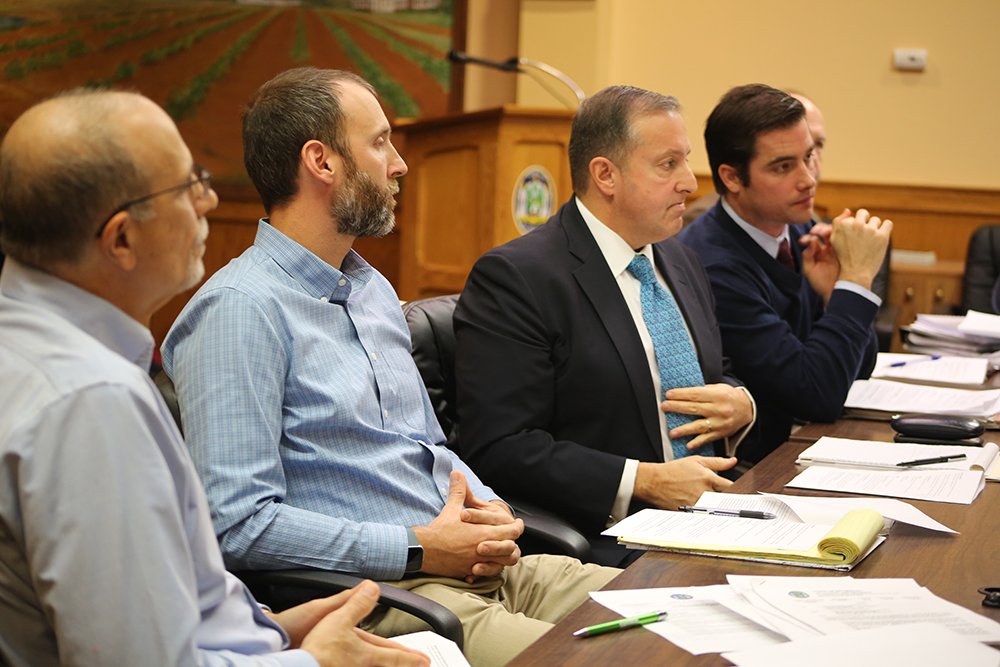Addressing concerns on proposed solar project in Calverton

Representatives of a proposed 191-acre solar farm in Calverton addressed concerns about the project, mainly environmental issues such as materials used in the panels, and also tree clearing, noise issues and fire hazards, at a Riverhead Town Board work session Thursday.
The officials from LI Solar Generation, which is a joint venture of NextEra Energy Resources and National Grid, answered questions for nearly two hours, many in response to those raised during a special meeting last week.
“This is really a low to zero impact project,” said Steven Losquadro of Rocky Point, the applicants’ attorney, who commended the town’s planning staff for its efforts to request information throughout the process.
The application is for a site plan and special permit for 22.9-megawatt commercial solar energy production facility at 149 Edwards Ave. and River Road in Calverton.
The Town Board, which is the lead agency in the review of the project, decided at last week’s meeting to hold off on declaring a “negative declaration” for the project, a move that would have removed the requirement for an environmental impact study. Residents had expressed concern the project was being rushed and information was lacking. But during Thursday morning’s meeting, the Town Board decided to move forward with a State Environmental Quality Review Act, saying that all bases must be covered for a facility and undertaking of this magnitude. Councilwoman Jodi Giglio argued that environmental analysis should be left to experts and the board should follow their lead.
The project has been before the Riverhead Planning Board and the officials met with the Town Board once before in May.
A key concern that had been raised was whether cadmium was used in the approximately 80,000 solar panels.
The officials said none of the solar panels would contain cadmium, a potentially hazardous material, or lead. Instead, the solar panels will consist of glass, polymer, aluminum, copper and semiconductor materials that can be recovered and recycled, according to Mr. Losquadro.
Supervisor Laura Jens-Smith questioned whether panels would be replaced as technology evolves. Michael Dowling, NextEra Energy project director, said the project is designed to maintain the current setup. Panels would be replaced on a case-by-case basis if they were damaged. Any panels that need to be replaced would be recycled, Mr. Dowling said.
The applicants are requesting a 20-year special permit with two five-year extensions granted up front to ensure that they are able to abide by their 30-year contract with Long Island Power Authority, Mr. Dowling said.
“The bottom line,” Councilman Tim Hubbard said, “what is the benefit to a Riverhead resident if you come in and build this here?”
He said the project will not be a job generator and asked the officials what positive impacts would be made.
“I have to weigh the pros and cons,” Mr. Hubbard said, “and I’ve got to be honest with you, the cons, to me, outweigh the pros.”
Mr. Dowling explained that a handful of temporary positions will be created for labor men, electrical technicians and high voltage technicians for roughly the first eight months, after which much of the operations will be remotely controlled out of state. He added that the solar farm will result in significant tax revenue.
Mr. Losquadro mentioned that with Long Island’s grid, power plants are highly antiquated and that turning to renewable energy is critical. Ms. Jens-Smith said Riverhead is now so heavily invested in solar energy that industrial uses seem only to focus on solar.
The energy, Mr. Dowling said, will be sold to LIPA, whose officials will use their discretion when distributing across the island. Councilwoman Catherine Kent said that’s not reassuring for local residents who want to see a direct benefit from the farm.
“We have to think about how much more solar are we willing to take in this town,” she said.
Chris Corrado, environmental manager at National Grid, addressed concerns raised about fuel used at the site. He said there will be 11 inverter units on the farm, containing 650 gallons of mineral oil, or dielectric fluid, which is noncombustible. There will also be an on-site generator step-up transformer that will contain between 5,000 and 7,000 gallons of mineral oil, with specific procedures in place in the “unlikely event of a spill,” the officials said. Mr. Corrado insisted that mineral oil does not contain hazardous materials.
With reference to further environmental review, Phase 1A and 1B archaeological studies have been completed with no further requirements. Both the U.S. Fish and Wildlife Service and the State DEC’s Natural Heritage Program identified potentially occurring federal and state protected species in the general vicinity of the project, including the tiger salamander. No significant tree clearing or clearing of native vegetation is being proposed at this time, but minimal tree removal is expected to be limited to formal, non-natural, landscaped trees. Regarding wetlands, the officials said they are in compliance with all zoning and setback requirements.
“The chances for the protected species would be in the wetland areas,” said Bill Boer, environmental services project manager for NextEra Energy. “We’re only disturbing previously disturbed parcels … There is no existing habitat for any endangered species.”









